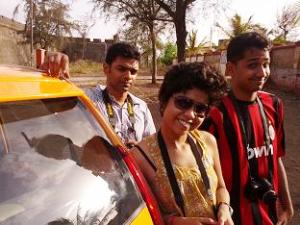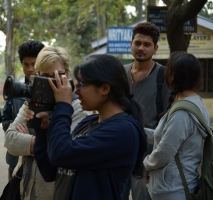When writing a work of fiction, the larger theme or the broad idea of what you want to convey is always present before you. But on a day to day basis, what occupy you are the highly specific things -- the individual scenes, how the characters think from one moment to the next, what a room or a street should look like, how a feeling could be described, how best to write the opening lines of a dialogue when two people meet for the first time.
The big picture is in your mind. But it emerges into reality only through the labour of planning, writing out, organising and re-organising these tiny fictional details, day after day and week after week.
When the book is finally published, or about to be, and that familiar question is raised -- what is this work of fiction about? -- Your first reaction is to say, or least think: It's not about any one thing! The long process of writing by painstakingly accumulating detail after detail makes the final work feel like an ocean in which you've been immersed. After all this time, it's hard to raise your head from the water and pinpoint that one wave which best expresses the nature of this ocean.
When my first novel, Lunatic in my Head, was published in 2007, most readers responded to it as a contemporary novel about the city of Shillong. I echoed that view because it seemed impossible to refute: my novel was set in Shillong; its characters thought a great deal about their city and their lives in it; it contained descriptions of localities, weather, topography, houses, and the people of the city. How could it not be about Shillong?
I said in interviews that my novel was an attempt to write about the city in a modern way, depict it as typically urban in that it was home to people from many different communities and walks of life.
While writing the novel, however, all this had been true for me only in a very distant sense. I described the city of Shillong because I believed that's how fiction is written - by attempting to bring to life the setting in which events of the novel are taking place. And the characters acquired distinction not as representatives of this or that community but as ordinary men and women, as enmeshed in the events of the novel as real people are enmeshed in the circumstances of daily life. There were a large variety of characters of different ethnicities in Lunatic in my Head not because I set out to write a representative novel but because I could not write the stories I wanted to in any other way.
The fact that people read the novel as being 'about' Shillong (and therefore holding up a mirror to reality) both delighted and confounded me. I was happy because this signalled to me that I had succeeded in evoking the city and its people. At the same time, I did not want my readers to think of the novel as straightforwardly 'real'. I wanted them to realise that Lunatic in my Head was only one out of countless possible ways of imagining the city. This ambiguity - both wanting your readers to believe in the reality of your fiction and yet resisting such an attitude - is central to the reading and writing of fiction, says Orhan Pamuk in The Naive and Sentimental Novelist, his wonderful exposition on the art of the novel.
...the art of the novel draws its power from the absence of a perfect consensus between writer and reader on the understanding of fiction. Readers and authors acknowledge and agree on the fact that novels are neither completely imaginary nor completely factual. But as we read a novel, word after word, sentence after sentence, this awareness is transformed into questioning, into a strong and focused curiosity. Clearly the writer must have experienced something of the sort, the reader thinks, but perhaps he has exaggerated or imagined part of it.
Two years after Lunatic, my second novel, Neti Neti appeared. This was about a young woman called Sophie Das who leaves Shillong to work in Bangalore. She enjoys the liberties of the big city -- a job, living on her own, a boyfriend -- and yet the limitless hunger of the city also oppresses her. I wanted to look at Bangalore through the eyes of this girl who is alienated from her family, not completely in love with her boyfriend, at loggerheads with her landlord, and disillusioned about her job. The novel is about her situation and how this coalesces in her imagination into an experience of the city. However, when, once again, that familiar question was raised about Neti, Neti, the question of what the novel was 'about', the most obvious answer seemed to be that this was a novel 'about Bangalore'.
Yet again I felt an emotion that was in equal parts disquiet and satisfaction. I was happy to hear from some readers that the novel captured their own sentiments about and experiences in Bangalore but I was also anxious for them to appreciate that they were reading about Bangalore in a novel, which was different from reading about it in a newspaper report or a work of non-fiction. Bangalore in Neti, Neti was a city seen through the eyes of Sophie Das. The Mexican novelist Carlos Fuentes has said that all writers are like Don Quixote. We try to live what we read and we go out and fall flat on our faces. He goes on to describe Flaubert's Madame Bovary as a daughter of Don Quixote.
I think of my character Sophie as the daughter of Madame Bovary. This older, famous fictional character is a touchstone for my dreamy and discontented Sophie, but believing so deeply in the fiction of Madame Bovary could mean going out and falling flat on your face just as the character Madame Bovary herself reads French romances and starts to believe that she can live them. So another way of looking at Neti, Neti could be that it is a novel about a girl who confuses fiction with reality.
When writing my third work of fiction, Difficult Pleasures, it was this concern running in the back of my mind: how to reveal to the reader the special nature of fiction -- which is that a story or a novel can both be about reality and yet be a work of imagination. Carlos Fuentes has this to say about this quality that is special to literature, and it captured my concern perfectly:
...people are accustomed in the everyday world to believe that knowledge is acquired through science, ethics, philosophy, and politics...However, literature has a particular knowledge of its own which is called imagination, which is not given to us by science, or by politics, or by ethics, but which makes ethics and politics and science possible because literature takes place in the origin of language constantly.
The stories in Difficult Pleasures were written one at a time and not with the idea of bringing them together in a collection; yet in each of them, I was interested in creating a fiction that does not submit to an easy answer regarding the question: what is this story about?
In other words, I did not want to write fictions that were obviously 'about' anything other than the characters driving the stories, the specific events taking place in them and the descriptions they contained.
This is not to say that I was hoping to write in an obscure way or create stories whose meanings are difficult to decode. The stories in Difficult Pleasures are in many ways traditional; even though my characters tend to be brooding and introspective, the question -- what happened next? -- can be raised and answered about each of these stories. These are stories with a beginning, middle and end, stories where one thing triggers another and this chain of events moves the narrative forward.
Is there anything uniting the stories? My characters are often solitary people whose choices are no longer so determined by older social mores, but who therefore have to invent their freedoms. A young photographer tries to find his own path; a girl decides to take an overnight journey on a whim; a married woman has an impulsive affair; a boy runs away from school. Fiction, and especially the short story, can be used to great effect to talk about the individual, the particular, the moment, the fleeting.
What I wanted to do in Difficult Pleasures is show how a work of fiction is sui generis: it cannot be likened or reduced to anything else. In writing a story, one is writing nothing more, but also nothing less, than 'just' a story.
Find us on facebook: facebook.com/TheThumbPrintMag







































